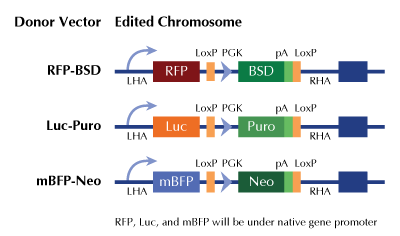CD22 Human Gene Knockout Kit (CRISPR)
CAT#: KN216939RB
CD22 - human gene knockout kit via CRISPR, HDR mediated
Functional Cassette: GFP-puro Luciferase-Puro mBFP-Neo
HDR-mediated knockout kit validation
USD 1,657.00
4 Weeks*
Specifications
| Product Data | |
| Format | 2 gRNA vectors, 1 RFP-BSD donor, 1 scramble control |
| Donor DNA | RFP-BSD |
| Symbol | CD22 |
| Locus ID | 933 |
| Components |
KN216939G1, CD22 gRNA vector 1 in pCas-Guide CRISPR vector KN216939G2, CD22 gRNA vector 2 in pCas-Guide CRISPR vector KN216939RBD, donor DNA containing left and right homologous arms and RFP-BSD functional cassette. GE100003, scramble sequence in pCas-Guide vector |
| Disclaimer | These products are manufactured and supplied by OriGene under license from ERS. The kit is designed based on the best knowledge of CRISPR technology. The system has been functionally validated for knocking-in the cassette downstream the native promoter. The efficiency of the knock-out varies due to the nature of the biology and the complexity of the experimental process. |
| Reference Data | |
| RefSeq | NM_001185099, NM_001185100, NM_001185101, NM_001278417, NM_001771 |
| UniProt ID | P20273 |
| Synonyms | SIGLEC-2; SIGLEC2 |
| Summary | Mediates B-cell B-cell interactions. May be involved in the localization of B-cells in lymphoid tissues. Binds sialylated glycoproteins; one of which is CD45. Preferentially binds to alpha-2,6-linked sialic acid. The sialic acid recognition site can be masked by cis interactions with sialic acids on the same cell surface. Upon ligand induced tyrosine phosphorylation in the immune response seems to be involved in regulation of B-cell antigen receptor signaling. Plays a role in positive regulation through interaction with Src family tyrosine kinases and may also act as an inhibitory receptor by recruiting cytoplasmic phosphatases via their SH2 domains that block signal transduction through dephosphorylation of signaling molecules.[UniProtKB/Swiss-Prot Function] |
Documents
| Product Manuals |
| FAQs |
| SDS |
Resources
Other Versions
| SKU | Description | Size | Price |
|---|---|---|---|
| KN216939 | CD22 - human gene knockout kit via CRISPR, HDR mediated |
USD 1,657.00 |
|
| KN216939BN | CD22 - human gene knockout kit via CRISPR, HDR mediated |
USD 1,657.00 |
|
| KN216939LP | CD22 - human gene knockout kit via CRISPR, HDR mediated |
USD 1,657.00 |
|
| KN416939 | CD22 - KN2.0, Human gene knockout kit via CRISPR, non-homology mediated. |
USD 1,657.00 |
|
| GA100660 | CD22 CRISPRa kit - CRISPR gene activation of human CD22 molecule |
USD 1,657.00 |
{0} Product Review(s)
Be the first one to submit a review






























































































































































































































































 Germany
Germany
 Japan
Japan
 United Kingdom
United Kingdom
 China
China
